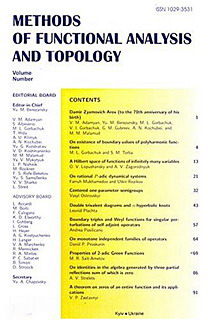Vol. 16 (2010), no. 2
Maharam traces on von Neumann algebras
MFAT 16 (2010), no. 2, 101-111
101-111
Traces $\Phi$ on von Neumann algebras with values in complex order complete vector lattices are considered. The full description of these traces is given for the case when $\Phi$ is the Maharam trace. The version of Radon-Nikodym-type theorem for Maharam traces is established.
GC-Fusion frames
M. H. Faroughi, A. Rahimi, R. Ahmadi
MFAT 16 (2010), no. 2, 112-119
112-119
In this paper we introduce the generalized continuous version of fusion frame, namely $gc$-fusion frame. Also we get some new results about Bessel mappings and perturbation in this case.
Regularization of singular Sturm-Liouville equations
Andrii Goriunov, Vladimir Mikhailets
MFAT 16 (2010), no. 2, 120-130
120-130
The paper deals with the singular Sturm-Liouville expressions $$l(y) = -(py')' + qy$$ with the coefficients $$q = Q', \quad 1/p, Q/p, Q^2/p \in L_1, $$ where the derivative of the function $Q$ is understood in the sense of distributions. Due to a new regularization, the corresponding operators are correctly defined as quasi-differentials. Their resolvent approximation is investigated and all self-adjoint and maximal dissipative extensions and generalized resolvents are described in terms of homogeneous boundary conditions of the canonical form.
Systems of one-dimensional subspaces of a Hilbert space
R. V. Grushevoy, Yu. S. Samoilenko
MFAT 16 (2010), no. 2, 131-139
131-139
We study systems of one-dimensional subspaces of a Hilbert space. For such systems, symmetric and orthoscalar systems, as well as graph related configurations of one-dimensional subspaces have been studied.
A spectral decomposition in one class of non-selfadjoint operators
G. M. Gubreev, M. V. Dolgopolova, S. I. Nedobachiy
MFAT 16 (2010), no. 2, 140-157
140-157
In this paper, a class of special finite dimensional perturbations of Volterra operators in Hilbert spaces is investigated. The main result of the article is finding necessary and sufficient conditions for an operator in a chosen class to be similar to the orthogonal sum of a dissipative and an anti-dissipative operators with finite dimensional imaginary parts.
Hyperspaces of closed limit sets
MFAT 16 (2010), no. 2, 158-166
158-166
We study Michael's lower semifinite topology and Fell's topology on the collection of all closed limit subsets of a topological space. Special attention is given to the subfamily of all maximal limit sets.
Functions on surfaces and incompressible subsurfaces
MFAT 16 (2010), no. 2, 167-182
167-182
Let $M$ be a smooth connected compact surface, $P$ be either a real line $\mathbb R$ or a circle $S^1$. Then we have a natural right action of the group $D(M)$ of diffeomorphisms of $M$ on $C^\infty(M,P)$. For $f\in C^\infty(M,P)$ denote respectively by $S(f)$ and $O(f)$ its stabilizer and orbit with respect to this action. Recently, for a large class of smooth maps $f:M\to P$ the author calculated the homotopy types of the connected components of $S(f)$ and $O(f)$. It turned out that except for few cases the identity component of $S(f)$ is contractible, $\pi_i O(f)=\pi_i M$ for $i\geq3$, and $\pi_2 O(f)=0$, while $\pi_1 O(f)$ it only proved to be a finite extension of $\pi_1D_{Id}M\oplus\mathbb Z^{l}$ for some $l\geq0$. In this note it is shown that if $\chi(M)<0$, then $\pi_1O(f)=G_1\times\cdots\times G_n$, where each $G_i$ is a fundamental group of the restriction of $f$ to a subsurface $B_i\subset M$ being either a $2$-disk or a cylinder or a Mobius band. For the proof of main result incompressible subsurfaces and cellular automorphisms of surfaces are studied.
Strong compact properties of the mappings and K-Radon-Nikodym property
MFAT 16 (2010), no. 2, 183-196
183-196
For mappings acting from an interval into a locally convex space, we study properties of strong compact variation and strong compact absolute continuity connected with an expansion of the space into subspaces generated by the compact sets. A description of strong $K$-absolutely continuous mappings in terms of indefinite Bochner integral is obtained. A special class of the spaces having $K$-Radon-Nikodym property is obtained. A relation between the $K$-Radon-Nikodym property and the classical Radon-Nikodym property is considered.


